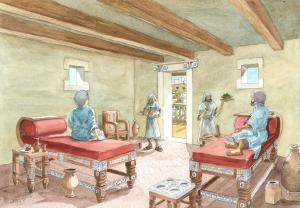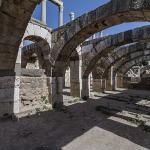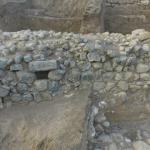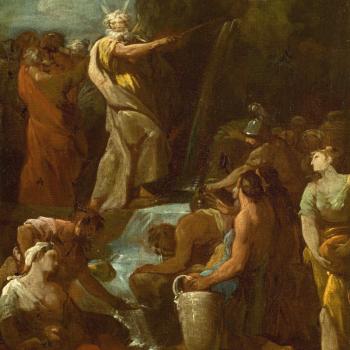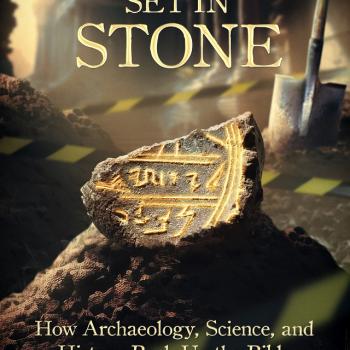[click to enlarge image]
George Haddad reports on this new discovery in his article, “Period Ivories Discovered in the City of David” (Armstrong Institute of Biblical Archaeology, 9-7-22). He writes:
Around 1,500 rare and ornate decorated ivory fragments were discovered in the City of David archaeological site known as the Givati Parking Lot excavations, located just southeast of the Old City, in an excavation led by Prof. Yuval Gadot of Tel Aviv University and Dr. Yiftah Shalev of the Israel Antiquities Authority. A press release regarding the discovery was released Monday.
The delicate sherds, which had been crushed and burned, appear to have been originally housed in a monumental royal structure until the Babylonian destruction of 586 b.c.e. Experts carefully reassembled the fragments into 12 small square plates that would have decorated a lavish wooden throne or chair.
Sourced from elephant tusks, ivory of this type was a luxury item that was used as an inlay for thrones and furniture. The material took great skill to work with, especially to achieve such intricate decorations as seen on these plates. Both Assyria’s powerful capital, Nimrud, and the northern Israelite capital, Samaria, have had similar discoveries dating to the First Temple period. However, this is the first time this type of ivory—one of the most expensive raw materials in the ancient world (even more so than gold!)—has been found in Jerusalem, providing insight into the wealth and status of the city. . . .
Professor Gadot and Dr. Shalev explain: “The assemblage of ivory discovered in the City of David was probably imported, and originally made by artisans from Assyria. The ivories may have come to Jerusalem as a gift from Assyria to Jerusalem’s nobility. Following a comparison with complete objects that appear on wall plaques from the palace of the Assyrian King Sennacherib at Nineveh, we suggest that the ivory plaques from Jerusalem were originally inlaid in a couch-throne, . . .”
It is thought that references to the ivory throne of Solomon (10th c. BC) likely refer to the same sort of inlaid ivory that is seen in the “couch-thrones” (see photo above):
1 Kings 10:18 (RSV) The king also made a great ivory throne, and overlaid it with the finest gold. (cf. 2 Chr 9:17)
Twelve references to ivory occur in the Old Testament, including King Ahab’s “ivory house” (1 Kgs 22:39), “houses of ivory” (Amos 3:15), ships bringing ivory to Israel, along with silver and gold (1 Kgs 10:22; 2 Chr 9:21), and “ivory palaces” (Ps 45:8). One passage states where it came from:
Ezekiel 27:15 The men of Rhodes traded with you; many coastlands were your own special markets, they brought you in payment ivory tusks and ebony.
Rhodes is an island of Greece, located south of western Turkey, in the Mediterranean Sea. I Kings 10:22 (cf. 2 Chr 9:21) refers to “ships of Tarshish” bringing ivory, but scholars aren’t certain what “Tarshish” referred to. The phrase itself is believed by some to signify a class of ships: large vessels equipped for long-distance trade. The Bible states that King Solomon “had a fleet” of such ships, “with the fleet of Hiram” (1 Kgs 10:22). Hiram was the Phoenician king of Tyre, whose reign was c. 980 to 947 BC.
The maritime accomplishments of the Phoenicians in this period are well-known. Hiram is said to have sent to King David “cedar trees, also carpenters and masons who built David a house” (2 Sam 5:11; cf. 1 Chr 14:1), and the Bible informs us that he “always loved David” and “sent his servants to Solomon” (1 Kgs 5:1). Hiram is documented in the writings of Menander of Ephesus (early 2nd c. BC): preserved in Josephus’ defense of Judaism, Against Apion. Josephus wrote that he reigned for 34 years.
Perhaps of most interest related to our topic, the Bible (in a passage about Tyre in Lebanon) refers to a “deck of pines from the coasts of Cyprus, inlaid with ivory” (Ezek 27:6), and to “beds of ivory,” also called “couches” (Amos 6:4). The prophet Amos was condemning what he thought was excessive luxury and materialism. We know that Amos was active around 750 BC and lived in the kingdom of Judah but preached in the northern kingdom of Israel, which by then had separated from Judah, and had all wicked kings (hence, Amos’ denunciations). This was some 200 years after King Solomon.
It’s important to understand the continuing skepticism of a fair number of scholars, who irrationally dismiss the biblical historical evidence. Wikipedia (“Tarshish”) noted that:
the lack of evidence for wealth in Israel and Phoenicia during the reigns of Solomon and Hiram, respectively, prompted a few scholars to opine that the archaeological period in Mediterranean prehistory between 1200 and 800 BC was a ‘Dark Age’.
The source cited for this opinion is “Mediterranean peoples in transition, thirteenth to early tenth centuries B.C.E. : International symposium, Jerusalem, April 3-7, 1995: abstracts,” published by the Philip & Muriel Berman Center for Biblical Archaeology, Institute of Archaeology, The Hebrew University of Jerusalem: Israel Exploration Society.
I submit that this massive find of a vast collection of inlaid ivory, found right near the site of Solomon’s Temple in Jerusalem, goes against such a skeptical theory of the lack of wealth in Jerusalem at that time. My recent paper about ancient imports of tin and lead during the time of the judges (c. 1200-1050 BC: before Saul, David, and Solomon) also supports such a view. Ivory was a great luxury in the ancient world, and very costly. Marga Patterson writes in her piece, “A Luxurious Desire: Ancient Near Eastern Ivory Carvings” (Daily Art Magazine, 10-154-22):
Most of the ivory carvings discovered at ancient Assyrian sites were carved from elephant tusks sourced from Syrian elephants until the animal became extinct sometime between the 8th and 7th century BCE. Ivory was then imported from Egypt and other parts of Africa.
In the ancient Near East, ivory carving was a valuable industry and it is likely that every major city center had ivory workshops, including those specializing in creating luxury items for royalty and the elite. Ivory is easy to carve, it’s an organic material that endures time. Ivory carving traditions were found in the regions of the ancient Near East and each culture possessed its own distinctive styles and techniques. . . .
In ancient Mesopotamia, ivory was associated with wealth, royalty, and luxury. A large majority of ivory carvings were small plaques that were used in elements of furniture decoration, . . .
This article includes many wonderful photographs of ancient carved ivory.
Bottom line: the Bible has been proven to be historically accurate for the 3,975,387th time
***
Further Related Reading
My book, The Word Set in Stone: How Archaeology, Science, and History Back up the Bible (Catholic Answers Press, March 2023)
***
Practical Matters: Perhaps some of my 4,000+ free online articles (the most comprehensive “one-stop” Catholic apologetics site) or fifty books have helped you (by God’s grace) to decide to become Catholic or to return to the Church, or better understand some doctrines and why we believe them.
Or you may believe my work is worthy to support for the purpose of apologetics and evangelism in general. If so, please seriously consider a much-needed financial contribution. I’m always in need of more funds: especially monthly support. “The laborer is worthy of his wages” (1 Tim 5:18, NKJV). 1 December 2021 was my 20th anniversary as a full-time Catholic apologist, and February 2022 marked the 25th anniversary of my blog.
PayPal donations are the easiest: just send to my email address: apologistdave@gmail.com. You’ll see the term “Catholic Used Book Service”, which is my old side-business. To learn about the different methods of contributing, including 100% tax deduction, etc., see my page: About Catholic Apologist Dave Armstrong / Donation Information. Thanks a million from the bottom of my heart!
***
Photo credit: [Shalom Kweller / City of David]
***
Summary: A large collection of Solomon’s Temple-period ivory has been found in the ancient City of David archaeological site, right near the original temple in Jerusalem.


